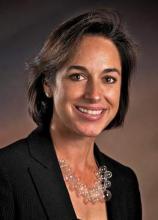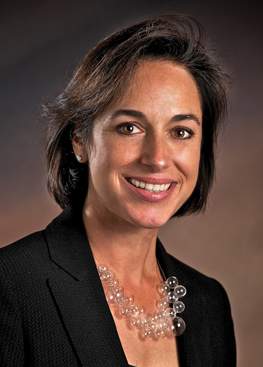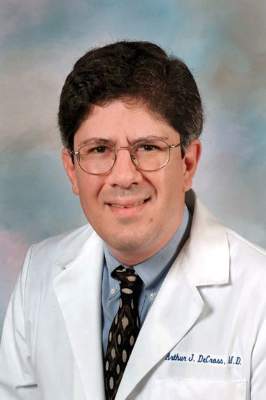User login
Happy holidays from Medicare: 250,000 docs to get meaningful use penalty
About 257,000 doctors and other medical professionals, or about 50% of those eligible to participate in the electronic health record incentive program, are about to get a holiday “gift” from Medicare: a 1% reduction in Medicare pay.
The reduction will come from 2015 Medicare payments to doctors who failed to meet meaningful use requirements during a 2013 reporting period or did not receive a hardship exemption, according to the Centers for Medicare & Medicaid Services
The penalties apply to those who have not met Stage 1 of the meaningful use criteria, and given how few have attested to meeting Stage 2 so far, the number of doctors and providers being penalized could go significantly higher.
“It speaks to how hard it is” to meet the meaningful use criteria, commented Dr. Neil Skolnik, a family physician in Jenkintown, Penn. “What it’s creating is a lot of disgruntlement among physicians who aren’t meeting [meaningful use]. ... People really resent that. They are burdened by working hard to make the [EHR] work in their office and then getting a penalty. Even though they have the [EHR], they’re not meeting all the criteria. It’s a big deal. It’s really hard on people.”
Physicians continue to press CMS to reduce the 2015 attestation period for meeting meaningful use Stage 2 to 90 days, down from the current full-year requirement.
In a Dec. 15 letter to federal officials, the American College of Cardiology said it remains “unconvinced that significant numbers of [eligible professionals] and [eligible hospitals] will be able to meet the current requirements of reporting for a full year in 2015 and urge CMS and [the Office of the National Coordinator for Heath Information Technology] to adjust the 2015 reporting period to the 90 days originally afforded to [eligible professionals] and [eligible hospitals] for 2014.”
The cardiologists added that by pushing for a full-year attestation period, “CMS and ONC are setting EPs and EHs up for failure. ... It is simply too much to expect them to ... meet a full year reporting requirement, especially when coupled with implementation of the penalty phase of the federal EHR Incentive program, the value-based payment program, the Physician Quality Reporting System penalties, and ICD-10 implementation.”
About 257,000 doctors and other medical professionals, or about 50% of those eligible to participate in the electronic health record incentive program, are about to get a holiday “gift” from Medicare: a 1% reduction in Medicare pay.
The reduction will come from 2015 Medicare payments to doctors who failed to meet meaningful use requirements during a 2013 reporting period or did not receive a hardship exemption, according to the Centers for Medicare & Medicaid Services
The penalties apply to those who have not met Stage 1 of the meaningful use criteria, and given how few have attested to meeting Stage 2 so far, the number of doctors and providers being penalized could go significantly higher.
“It speaks to how hard it is” to meet the meaningful use criteria, commented Dr. Neil Skolnik, a family physician in Jenkintown, Penn. “What it’s creating is a lot of disgruntlement among physicians who aren’t meeting [meaningful use]. ... People really resent that. They are burdened by working hard to make the [EHR] work in their office and then getting a penalty. Even though they have the [EHR], they’re not meeting all the criteria. It’s a big deal. It’s really hard on people.”
Physicians continue to press CMS to reduce the 2015 attestation period for meeting meaningful use Stage 2 to 90 days, down from the current full-year requirement.
In a Dec. 15 letter to federal officials, the American College of Cardiology said it remains “unconvinced that significant numbers of [eligible professionals] and [eligible hospitals] will be able to meet the current requirements of reporting for a full year in 2015 and urge CMS and [the Office of the National Coordinator for Heath Information Technology] to adjust the 2015 reporting period to the 90 days originally afforded to [eligible professionals] and [eligible hospitals] for 2014.”
The cardiologists added that by pushing for a full-year attestation period, “CMS and ONC are setting EPs and EHs up for failure. ... It is simply too much to expect them to ... meet a full year reporting requirement, especially when coupled with implementation of the penalty phase of the federal EHR Incentive program, the value-based payment program, the Physician Quality Reporting System penalties, and ICD-10 implementation.”
About 257,000 doctors and other medical professionals, or about 50% of those eligible to participate in the electronic health record incentive program, are about to get a holiday “gift” from Medicare: a 1% reduction in Medicare pay.
The reduction will come from 2015 Medicare payments to doctors who failed to meet meaningful use requirements during a 2013 reporting period or did not receive a hardship exemption, according to the Centers for Medicare & Medicaid Services
The penalties apply to those who have not met Stage 1 of the meaningful use criteria, and given how few have attested to meeting Stage 2 so far, the number of doctors and providers being penalized could go significantly higher.
“It speaks to how hard it is” to meet the meaningful use criteria, commented Dr. Neil Skolnik, a family physician in Jenkintown, Penn. “What it’s creating is a lot of disgruntlement among physicians who aren’t meeting [meaningful use]. ... People really resent that. They are burdened by working hard to make the [EHR] work in their office and then getting a penalty. Even though they have the [EHR], they’re not meeting all the criteria. It’s a big deal. It’s really hard on people.”
Physicians continue to press CMS to reduce the 2015 attestation period for meeting meaningful use Stage 2 to 90 days, down from the current full-year requirement.
In a Dec. 15 letter to federal officials, the American College of Cardiology said it remains “unconvinced that significant numbers of [eligible professionals] and [eligible hospitals] will be able to meet the current requirements of reporting for a full year in 2015 and urge CMS and [the Office of the National Coordinator for Heath Information Technology] to adjust the 2015 reporting period to the 90 days originally afforded to [eligible professionals] and [eligible hospitals] for 2014.”
The cardiologists added that by pushing for a full-year attestation period, “CMS and ONC are setting EPs and EHs up for failure. ... It is simply too much to expect them to ... meet a full year reporting requirement, especially when coupled with implementation of the penalty phase of the federal EHR Incentive program, the value-based payment program, the Physician Quality Reporting System penalties, and ICD-10 implementation.”
Dermatologist, consumer advocate named to new FDA compounding advisory committee
Physicians, pharmacists, industry representatives, and a consumer advocate have been named to the Food and Drug Administration’s new Pharmacy Compounding Advisory Committee.
The advisory committee, announced Dec. 16, will provide “advice on scientific, technical, and medical issues concerning drug compounding [and] make appropriate recommendations to the Commissioner of Food and Drugs.”
The committee is made up of 14 members, two of whom are nonvoting, and includes representation from the National Boards of Pharmacy, the U.S. Pharmacopeia, pharmacists with current expertise in compounding, physicians with background and knowledge in compounding, and patient and public health advocacy organizations.
“This is a key step toward implementing the compounding provisions of the Drug Quality and Security Act, and I expect we will benefit greatly from the advice and recommendations the members of the committee provide,” Dr. Janet Woodcock, director of the FDA Center for Drug Evaluation and Research, said in a statement. The law was enacted followed a deadly 2012 meningitis outbreak linked to a steroid from a Framingham, Mass.–based drug compounder.
The dermatologist on the panel is Dr. John DiGiovanna, staff clinician at the National Cancer Institute in Bethesda, Md. Dr. Ned Braunstein, vice president and head of regulatory affairs at Regeneron Pharmaceuticals Inc., of Tarrytown, N.Y., brings his expertise in clinical rheumatology and molecular immunology to the committee. Representing consumers will be Dr. Michael Carome, director of the health research group at Public Citizen in Washington.
Physicians, pharmacists, industry representatives, and a consumer advocate have been named to the Food and Drug Administration’s new Pharmacy Compounding Advisory Committee.
The advisory committee, announced Dec. 16, will provide “advice on scientific, technical, and medical issues concerning drug compounding [and] make appropriate recommendations to the Commissioner of Food and Drugs.”
The committee is made up of 14 members, two of whom are nonvoting, and includes representation from the National Boards of Pharmacy, the U.S. Pharmacopeia, pharmacists with current expertise in compounding, physicians with background and knowledge in compounding, and patient and public health advocacy organizations.
“This is a key step toward implementing the compounding provisions of the Drug Quality and Security Act, and I expect we will benefit greatly from the advice and recommendations the members of the committee provide,” Dr. Janet Woodcock, director of the FDA Center for Drug Evaluation and Research, said in a statement. The law was enacted followed a deadly 2012 meningitis outbreak linked to a steroid from a Framingham, Mass.–based drug compounder.
The dermatologist on the panel is Dr. John DiGiovanna, staff clinician at the National Cancer Institute in Bethesda, Md. Dr. Ned Braunstein, vice president and head of regulatory affairs at Regeneron Pharmaceuticals Inc., of Tarrytown, N.Y., brings his expertise in clinical rheumatology and molecular immunology to the committee. Representing consumers will be Dr. Michael Carome, director of the health research group at Public Citizen in Washington.
Physicians, pharmacists, industry representatives, and a consumer advocate have been named to the Food and Drug Administration’s new Pharmacy Compounding Advisory Committee.
The advisory committee, announced Dec. 16, will provide “advice on scientific, technical, and medical issues concerning drug compounding [and] make appropriate recommendations to the Commissioner of Food and Drugs.”
The committee is made up of 14 members, two of whom are nonvoting, and includes representation from the National Boards of Pharmacy, the U.S. Pharmacopeia, pharmacists with current expertise in compounding, physicians with background and knowledge in compounding, and patient and public health advocacy organizations.
“This is a key step toward implementing the compounding provisions of the Drug Quality and Security Act, and I expect we will benefit greatly from the advice and recommendations the members of the committee provide,” Dr. Janet Woodcock, director of the FDA Center for Drug Evaluation and Research, said in a statement. The law was enacted followed a deadly 2012 meningitis outbreak linked to a steroid from a Framingham, Mass.–based drug compounder.
The dermatologist on the panel is Dr. John DiGiovanna, staff clinician at the National Cancer Institute in Bethesda, Md. Dr. Ned Braunstein, vice president and head of regulatory affairs at Regeneron Pharmaceuticals Inc., of Tarrytown, N.Y., brings his expertise in clinical rheumatology and molecular immunology to the committee. Representing consumers will be Dr. Michael Carome, director of the health research group at Public Citizen in Washington.
Feds call for more transparency in reporting clinical trial results
A proposal is being floated to make clinical trial results posted to ClinicalTrials.gov more transparent, complete, and timely, regardless of whether the trial is related to an approved product.
The Department of Health & Human Services posted a proposed rule for public inspection on Nov. 19 that would expand the reporting requirements for ClinicalTrials.gov to include results on all clinical trials that are required to register on the trials database, not just results for drugs and devices that are approved, licensed, or cleared for use. It also expands data elements that are accessible and proposes more frequent updating for certain data.
Other than phase I studies of drugs and biologics and small feasibility studies of devices, trials involving drugs and devices regulated by the Food and Drug Administration would be subject to the reporting requirement under this proposal, irrespective of who is funding the study.
A separate proposal by the National Institutes of Health would apply the expanded reporting proposal to all trials funded by NIH, regardless of whether those trials would otherwise not be required to report to ClinicalTrials.gov under requirements set in the FDA Amendments Act of 2007.
“The scientific community has a disappointing track record for dissemination of clinical trial results,” NIH Deputy Director for Science, Outreach and Policy Kathy Hudson, Ph.D., and Director Dr. Francis Collins wrote in a viewpoint published in JAMA (2014 Nov. 19 [doi:10.1001/jama.2014.10716]) .
The NIH officials noted that a “recent analysis of 400 clinical studies revealed that 30% had not shared results through publication or through results reporting in ClinicalTrials.gov within 4 years of completion. This is a serious issue and the proposed rule underscores the intent of NIH to take strong action to promote timely dissemination of clinical trial results.”
Comments on the proposed rule are due within 90 days of its publication in the Federal Register on Nov. 21. The response date for comments on the NIH draft policy on reporting requirements for NIH-funded studies is Feb. 19, 2015.
A proposal is being floated to make clinical trial results posted to ClinicalTrials.gov more transparent, complete, and timely, regardless of whether the trial is related to an approved product.
The Department of Health & Human Services posted a proposed rule for public inspection on Nov. 19 that would expand the reporting requirements for ClinicalTrials.gov to include results on all clinical trials that are required to register on the trials database, not just results for drugs and devices that are approved, licensed, or cleared for use. It also expands data elements that are accessible and proposes more frequent updating for certain data.
Other than phase I studies of drugs and biologics and small feasibility studies of devices, trials involving drugs and devices regulated by the Food and Drug Administration would be subject to the reporting requirement under this proposal, irrespective of who is funding the study.
A separate proposal by the National Institutes of Health would apply the expanded reporting proposal to all trials funded by NIH, regardless of whether those trials would otherwise not be required to report to ClinicalTrials.gov under requirements set in the FDA Amendments Act of 2007.
“The scientific community has a disappointing track record for dissemination of clinical trial results,” NIH Deputy Director for Science, Outreach and Policy Kathy Hudson, Ph.D., and Director Dr. Francis Collins wrote in a viewpoint published in JAMA (2014 Nov. 19 [doi:10.1001/jama.2014.10716]) .
The NIH officials noted that a “recent analysis of 400 clinical studies revealed that 30% had not shared results through publication or through results reporting in ClinicalTrials.gov within 4 years of completion. This is a serious issue and the proposed rule underscores the intent of NIH to take strong action to promote timely dissemination of clinical trial results.”
Comments on the proposed rule are due within 90 days of its publication in the Federal Register on Nov. 21. The response date for comments on the NIH draft policy on reporting requirements for NIH-funded studies is Feb. 19, 2015.
A proposal is being floated to make clinical trial results posted to ClinicalTrials.gov more transparent, complete, and timely, regardless of whether the trial is related to an approved product.
The Department of Health & Human Services posted a proposed rule for public inspection on Nov. 19 that would expand the reporting requirements for ClinicalTrials.gov to include results on all clinical trials that are required to register on the trials database, not just results for drugs and devices that are approved, licensed, or cleared for use. It also expands data elements that are accessible and proposes more frequent updating for certain data.
Other than phase I studies of drugs and biologics and small feasibility studies of devices, trials involving drugs and devices regulated by the Food and Drug Administration would be subject to the reporting requirement under this proposal, irrespective of who is funding the study.
A separate proposal by the National Institutes of Health would apply the expanded reporting proposal to all trials funded by NIH, regardless of whether those trials would otherwise not be required to report to ClinicalTrials.gov under requirements set in the FDA Amendments Act of 2007.
“The scientific community has a disappointing track record for dissemination of clinical trial results,” NIH Deputy Director for Science, Outreach and Policy Kathy Hudson, Ph.D., and Director Dr. Francis Collins wrote in a viewpoint published in JAMA (2014 Nov. 19 [doi:10.1001/jama.2014.10716]) .
The NIH officials noted that a “recent analysis of 400 clinical studies revealed that 30% had not shared results through publication or through results reporting in ClinicalTrials.gov within 4 years of completion. This is a serious issue and the proposed rule underscores the intent of NIH to take strong action to promote timely dissemination of clinical trial results.”
Comments on the proposed rule are due within 90 days of its publication in the Federal Register on Nov. 21. The response date for comments on the NIH draft policy on reporting requirements for NIH-funded studies is Feb. 19, 2015.
Spike in Medicaid use of emergency services after expansion temporary
Concerns that Medicaid expansion could put pressure on budgets because of greater use of emergency department services may be put to rest, if California’s experience is reflected in other states.
That state’s Medicaid program saw an initial spike in usage of hospital inpatient and emergency department services; however, there was a “significant decline” in the use of these services the year after following expansion, according to the UCLA Center for Health Policy Research.
However, part of that may be tied to how California prepared for expansion, as authors notes that the research findings “suggest that early and significant investments in infrastructure and in improving the process of care delivery can effectively address some pent-up demand for health care services of previously uninsured populations. Lead author Nigel Lo, a research analyst at the center, and his colleagues note that in California, there was a Low-Income Health Program (LIHP) that served as a bridge to the state’s Medicaid expansion under the Affordable Care Act.
As the state planned to expand Medicaid services, the authors noted concern in California, not unlike elsewhere in the nation, newly eligible Medicaid enrollees “are expected to have a significant level of unmet need (pent-up demand) and disproportionately higher rates of costly emergency room visits and hospitalizations.”
But over time, those with the highest demand (defined as individuals who had previously not used county services prior to enrolling in LIHP) ultimately had usage on par with those who had the lowest demand.
High-demand LIHP enrollees in the first quarter of the program in July 2011 had 600 emergency room visits per 1,000 enrollees. By April 2013, visits dropped dramatically to 183 visits per 1,000 enrollees, a number that was relatively flat during the second full year enrolled in the LIHP program. By comparison, those with the lowest demand had 148 visits per 1,000 enrollees in July 2011 and 140 visits per 1,000 enrollees in April 2013. Hospitalization rates mirrored emergency room visits during this same period, while outpatient services were constant among all groups looked at.
In an interview, Mr. Lo said that the findings should address fears of runaway utilization. “We definitely didn’t see that,” he said. “The fact that there was no runaway utilization, I think, is really important because it implies that once they get into the system, [costs and utilization] become very predictable.”
Authors conclude that the findings have two significant implications for California and the nation.
“First, although newly eligible Medicaid enrollees have pent-up demand for care, this demand appears to decline rapidly after the first year of enrollment and becomes comparable to the demand with those with previous comprehensive coverage. Second, for the populations who were ‘pre-enrolled’ in coverage programs prior to Medicaid expansion in January 2014, much of the pent-up demand for expensive emergency room and hospital care has already been met.”
When looked at as a whole, the findings suggest that “the higher costs and utilization among newly enrolled Medicaid beneficiaries is a temporary rather than permanent phenomenon.”
Concerns that Medicaid expansion could put pressure on budgets because of greater use of emergency department services may be put to rest, if California’s experience is reflected in other states.
That state’s Medicaid program saw an initial spike in usage of hospital inpatient and emergency department services; however, there was a “significant decline” in the use of these services the year after following expansion, according to the UCLA Center for Health Policy Research.
However, part of that may be tied to how California prepared for expansion, as authors notes that the research findings “suggest that early and significant investments in infrastructure and in improving the process of care delivery can effectively address some pent-up demand for health care services of previously uninsured populations. Lead author Nigel Lo, a research analyst at the center, and his colleagues note that in California, there was a Low-Income Health Program (LIHP) that served as a bridge to the state’s Medicaid expansion under the Affordable Care Act.
As the state planned to expand Medicaid services, the authors noted concern in California, not unlike elsewhere in the nation, newly eligible Medicaid enrollees “are expected to have a significant level of unmet need (pent-up demand) and disproportionately higher rates of costly emergency room visits and hospitalizations.”
But over time, those with the highest demand (defined as individuals who had previously not used county services prior to enrolling in LIHP) ultimately had usage on par with those who had the lowest demand.
High-demand LIHP enrollees in the first quarter of the program in July 2011 had 600 emergency room visits per 1,000 enrollees. By April 2013, visits dropped dramatically to 183 visits per 1,000 enrollees, a number that was relatively flat during the second full year enrolled in the LIHP program. By comparison, those with the lowest demand had 148 visits per 1,000 enrollees in July 2011 and 140 visits per 1,000 enrollees in April 2013. Hospitalization rates mirrored emergency room visits during this same period, while outpatient services were constant among all groups looked at.
In an interview, Mr. Lo said that the findings should address fears of runaway utilization. “We definitely didn’t see that,” he said. “The fact that there was no runaway utilization, I think, is really important because it implies that once they get into the system, [costs and utilization] become very predictable.”
Authors conclude that the findings have two significant implications for California and the nation.
“First, although newly eligible Medicaid enrollees have pent-up demand for care, this demand appears to decline rapidly after the first year of enrollment and becomes comparable to the demand with those with previous comprehensive coverage. Second, for the populations who were ‘pre-enrolled’ in coverage programs prior to Medicaid expansion in January 2014, much of the pent-up demand for expensive emergency room and hospital care has already been met.”
When looked at as a whole, the findings suggest that “the higher costs and utilization among newly enrolled Medicaid beneficiaries is a temporary rather than permanent phenomenon.”
Concerns that Medicaid expansion could put pressure on budgets because of greater use of emergency department services may be put to rest, if California’s experience is reflected in other states.
That state’s Medicaid program saw an initial spike in usage of hospital inpatient and emergency department services; however, there was a “significant decline” in the use of these services the year after following expansion, according to the UCLA Center for Health Policy Research.
However, part of that may be tied to how California prepared for expansion, as authors notes that the research findings “suggest that early and significant investments in infrastructure and in improving the process of care delivery can effectively address some pent-up demand for health care services of previously uninsured populations. Lead author Nigel Lo, a research analyst at the center, and his colleagues note that in California, there was a Low-Income Health Program (LIHP) that served as a bridge to the state’s Medicaid expansion under the Affordable Care Act.
As the state planned to expand Medicaid services, the authors noted concern in California, not unlike elsewhere in the nation, newly eligible Medicaid enrollees “are expected to have a significant level of unmet need (pent-up demand) and disproportionately higher rates of costly emergency room visits and hospitalizations.”
But over time, those with the highest demand (defined as individuals who had previously not used county services prior to enrolling in LIHP) ultimately had usage on par with those who had the lowest demand.
High-demand LIHP enrollees in the first quarter of the program in July 2011 had 600 emergency room visits per 1,000 enrollees. By April 2013, visits dropped dramatically to 183 visits per 1,000 enrollees, a number that was relatively flat during the second full year enrolled in the LIHP program. By comparison, those with the lowest demand had 148 visits per 1,000 enrollees in July 2011 and 140 visits per 1,000 enrollees in April 2013. Hospitalization rates mirrored emergency room visits during this same period, while outpatient services were constant among all groups looked at.
In an interview, Mr. Lo said that the findings should address fears of runaway utilization. “We definitely didn’t see that,” he said. “The fact that there was no runaway utilization, I think, is really important because it implies that once they get into the system, [costs and utilization] become very predictable.”
Authors conclude that the findings have two significant implications for California and the nation.
“First, although newly eligible Medicaid enrollees have pent-up demand for care, this demand appears to decline rapidly after the first year of enrollment and becomes comparable to the demand with those with previous comprehensive coverage. Second, for the populations who were ‘pre-enrolled’ in coverage programs prior to Medicaid expansion in January 2014, much of the pent-up demand for expensive emergency room and hospital care has already been met.”
When looked at as a whole, the findings suggest that “the higher costs and utilization among newly enrolled Medicaid beneficiaries is a temporary rather than permanent phenomenon.”
Physicians shun Stage 2 of meaningful use
Of the 269,000 physicians and health care providers who successfully attested to Stage 1 of meaningful use, just 3,655 have successfully attested to Stage 2 and are ready to receive the incentive payment from Medicare. The Stage 2 deadline is Feb. 28.
For hospitals, the number is similarly weak: just 164 of 4,245 who successfully met the Stage 1 benchmarks have met those for Stage 2.
The totals – accurate as of the end of October – were reported Dec. 9 at a meeting of the Health IT Policy Committee, an advisory committee to the Office of the National Coordinator for Health Information Technology.
The low numbers reflect “the difficulty physicians are having in meeting the meaningful use program’s strict requirements and underlines the need for more flexibility and a shorter reporting period,” said Dr. Steven Stack, president-elect of the American Medical Association in a statement.
However, Dr. Steven Waldren, director of the Alliance for eHealth Innovation at the American Academy of Family Physicians, did not see a reason to panic yet.
“I think it’s probably fair to be nervous, but I still think we have a couple of months to actually see what happens,” Dr. Waldren said in an interview.
Dr. Waldren said several issues could affect physicians’ reporting time frames, including actually meeting Stage 2 criteria, coupled with difficulties that have been documented around implementing 2014-certified electronic health records.
“I think because of the heavy lifting, the numbers are going to be down from what we would think they should be based on this regular progression through the program,” he said.
“But I also think that we won’t know exactly what the magnitude of that decrease will be until after the February time frame.”
Of the 269,000 physicians and health care providers who successfully attested to Stage 1 of meaningful use, just 3,655 have successfully attested to Stage 2 and are ready to receive the incentive payment from Medicare. The Stage 2 deadline is Feb. 28.
For hospitals, the number is similarly weak: just 164 of 4,245 who successfully met the Stage 1 benchmarks have met those for Stage 2.
The totals – accurate as of the end of October – were reported Dec. 9 at a meeting of the Health IT Policy Committee, an advisory committee to the Office of the National Coordinator for Health Information Technology.
The low numbers reflect “the difficulty physicians are having in meeting the meaningful use program’s strict requirements and underlines the need for more flexibility and a shorter reporting period,” said Dr. Steven Stack, president-elect of the American Medical Association in a statement.
However, Dr. Steven Waldren, director of the Alliance for eHealth Innovation at the American Academy of Family Physicians, did not see a reason to panic yet.
“I think it’s probably fair to be nervous, but I still think we have a couple of months to actually see what happens,” Dr. Waldren said in an interview.
Dr. Waldren said several issues could affect physicians’ reporting time frames, including actually meeting Stage 2 criteria, coupled with difficulties that have been documented around implementing 2014-certified electronic health records.
“I think because of the heavy lifting, the numbers are going to be down from what we would think they should be based on this regular progression through the program,” he said.
“But I also think that we won’t know exactly what the magnitude of that decrease will be until after the February time frame.”
Of the 269,000 physicians and health care providers who successfully attested to Stage 1 of meaningful use, just 3,655 have successfully attested to Stage 2 and are ready to receive the incentive payment from Medicare. The Stage 2 deadline is Feb. 28.
For hospitals, the number is similarly weak: just 164 of 4,245 who successfully met the Stage 1 benchmarks have met those for Stage 2.
The totals – accurate as of the end of October – were reported Dec. 9 at a meeting of the Health IT Policy Committee, an advisory committee to the Office of the National Coordinator for Health Information Technology.
The low numbers reflect “the difficulty physicians are having in meeting the meaningful use program’s strict requirements and underlines the need for more flexibility and a shorter reporting period,” said Dr. Steven Stack, president-elect of the American Medical Association in a statement.
However, Dr. Steven Waldren, director of the Alliance for eHealth Innovation at the American Academy of Family Physicians, did not see a reason to panic yet.
“I think it’s probably fair to be nervous, but I still think we have a couple of months to actually see what happens,” Dr. Waldren said in an interview.
Dr. Waldren said several issues could affect physicians’ reporting time frames, including actually meeting Stage 2 criteria, coupled with difficulties that have been documented around implementing 2014-certified electronic health records.
“I think because of the heavy lifting, the numbers are going to be down from what we would think they should be based on this regular progression through the program,” he said.
“But I also think that we won’t know exactly what the magnitude of that decrease will be until after the February time frame.”
Studies: MOC saves money, may not improve quality of care
No difference was seen in quality of care provided by board-certified internists subject to Maintenance of Certification and those who are grandfathered into the older, periodic certification system, although a small reduction was seen in the cost of health care by MOC physicians.
Bradley Gray, Ph.D., of the American Board of Internal Medicine in Philadelphia and his colleagues compared ambulatory care–sensitive hospitalizations (ACSHs) in Medicare patients treated by two groups of general internists – 956 who certified in 1991 (subject to MOC) who treated 84,215 patients and 974 general internists who certified in 1989 (grandfathered out of MOC) who treated 69,830 similar patients. Their research was published Dec. 10 in JAMA (2014;312:2348-57 [doi:10.1001/jama.2014.12716]).
Comparisons were made between treatments occurring between 1999 and 2000 before the 2001 MOC requirement and in 2002-2005.
The annual rate of ACSHs per 1,000 beneficiaries grew from pre- to postcertification periods for both groups of physicians – from 37.9 to 61.8 for MOC-required physicians and from 37.0 to 61.4 for grandfathered physicians. MOC was not statistically associated with a difference in the growth of the annual ACSH rate between the cohorts.
However, there was a difference in cost. For MOC-required physicians, annual per-beneficiary health care costs increased from $5,157 in during the precertification period to $7,633 in the postcertification period. For grandfathered physicians, costs increased from $5,133 to $7,793.
Dr. Gray suggested the 2.5% decrease in growth of costs could be from better utilization of laboratory tests, imaging, and specialty tests by MOC physicians.
“During the study period, MOC consisted of passing a secure examination and completing medical knowledge modules,” Dr. Gray said. “These components consisted of vignette-based multiple-choice questions that provided general internists with feedback on their performance and were generally designed to help them use resources appropriately, particularly imaging and other diagnostic tests.”
Test prep and completing medical knowledge modules “may have led to more efficient care by reducing the need for referrals and consultations or reducing the ordering of low-value tests,” he said.
While individual physicians may not see a noticeable change in costs, “these small individual savings may be large at the population level because there are nearly 50 million Medicare beneficiaries with over a half a trillion dollars in annual Medicare health care expenditures, exclusive of costs borne by beneficiaries. ... Even if the true association with MOC is a small fraction of what we report, our estimates suggest savings likely far exceed the direct cost of administering the MOC program ... as well as indirect costs borne by physicians,” he added.
In a separate study, Dr. John Hayes of the Clement J. Zablocki Veterans Affairs Medical Center in Milwaukee and his colleagues found no significant difference between MOC-required internists and grandfathered internists in 10 primary care measures in a population of 68,213 patients at four VA medical centers from 2012 to 2013 (JAMA 2014;312:2358-63 [doi:10.1001/jama.2014.13992]).
“Our adjusted results showed no significant difference between holders of time-limited and time-unlimited certificates in the VA setting,” Dr. Hayes wrote. “To whatever extent a goal of MOC is to improve the quality of patient care, these findings raise questions of whether that goal is being achieved, at least among internists at these VA hospitals.”
Dr. Gray and several of his colleagues are employed by ABIM. One coauthor receives royalties related to assessment of clinical competence. Dr. Hayes and his colleagues disclosed no relevant conflicts of interest.
With limited evidence on the outcomes effects of renewing maintenance of certification, the American Medical Association in a recent policy update called for it to not be mandated as part of licensure, employment, and reimbursement. But there is value to MOC and physicians should be working to fixing what is wrong, according to Dr. Thomas Lee of Press Ganey, a health care consultancy.
“Professional societies and physicians have a duty to criticize the problems with MOC, but also to participate actively in improving it,” he said, adding that physicians “should work constructively to help MOC improve, much as physicians should work continuously to improve how they collaborate with colleagues and with patients. In addition, physicians must make the commitment to lifelong, meaningful learning to ensure that their knowledge and skills remain current and relevant. Patients would be disappointed by anything less. The medical profession may never fully understand the effect of MOC, but that does not mean that physicians should give up or stop trying to make it better. The MOC program is a work in progress, as are all good physicians.”
Dr. Thomas Lee is chief medical officer at Press Ganey, a South Bend, Indiana–based consultancy, and an internist and cardiologist at Brigham and Women’s Hospital in Boston. His comments were made in an editorial accompanying the studies (JAMA 2014;312:2340-42 [doi:10.1001/jama.2014.13566]). He disclosed no relevant conflicts of interest.
With limited evidence on the outcomes effects of renewing maintenance of certification, the American Medical Association in a recent policy update called for it to not be mandated as part of licensure, employment, and reimbursement. But there is value to MOC and physicians should be working to fixing what is wrong, according to Dr. Thomas Lee of Press Ganey, a health care consultancy.
“Professional societies and physicians have a duty to criticize the problems with MOC, but also to participate actively in improving it,” he said, adding that physicians “should work constructively to help MOC improve, much as physicians should work continuously to improve how they collaborate with colleagues and with patients. In addition, physicians must make the commitment to lifelong, meaningful learning to ensure that their knowledge and skills remain current and relevant. Patients would be disappointed by anything less. The medical profession may never fully understand the effect of MOC, but that does not mean that physicians should give up or stop trying to make it better. The MOC program is a work in progress, as are all good physicians.”
Dr. Thomas Lee is chief medical officer at Press Ganey, a South Bend, Indiana–based consultancy, and an internist and cardiologist at Brigham and Women’s Hospital in Boston. His comments were made in an editorial accompanying the studies (JAMA 2014;312:2340-42 [doi:10.1001/jama.2014.13566]). He disclosed no relevant conflicts of interest.
With limited evidence on the outcomes effects of renewing maintenance of certification, the American Medical Association in a recent policy update called for it to not be mandated as part of licensure, employment, and reimbursement. But there is value to MOC and physicians should be working to fixing what is wrong, according to Dr. Thomas Lee of Press Ganey, a health care consultancy.
“Professional societies and physicians have a duty to criticize the problems with MOC, but also to participate actively in improving it,” he said, adding that physicians “should work constructively to help MOC improve, much as physicians should work continuously to improve how they collaborate with colleagues and with patients. In addition, physicians must make the commitment to lifelong, meaningful learning to ensure that their knowledge and skills remain current and relevant. Patients would be disappointed by anything less. The medical profession may never fully understand the effect of MOC, but that does not mean that physicians should give up or stop trying to make it better. The MOC program is a work in progress, as are all good physicians.”
Dr. Thomas Lee is chief medical officer at Press Ganey, a South Bend, Indiana–based consultancy, and an internist and cardiologist at Brigham and Women’s Hospital in Boston. His comments were made in an editorial accompanying the studies (JAMA 2014;312:2340-42 [doi:10.1001/jama.2014.13566]). He disclosed no relevant conflicts of interest.
No difference was seen in quality of care provided by board-certified internists subject to Maintenance of Certification and those who are grandfathered into the older, periodic certification system, although a small reduction was seen in the cost of health care by MOC physicians.
Bradley Gray, Ph.D., of the American Board of Internal Medicine in Philadelphia and his colleagues compared ambulatory care–sensitive hospitalizations (ACSHs) in Medicare patients treated by two groups of general internists – 956 who certified in 1991 (subject to MOC) who treated 84,215 patients and 974 general internists who certified in 1989 (grandfathered out of MOC) who treated 69,830 similar patients. Their research was published Dec. 10 in JAMA (2014;312:2348-57 [doi:10.1001/jama.2014.12716]).
Comparisons were made between treatments occurring between 1999 and 2000 before the 2001 MOC requirement and in 2002-2005.
The annual rate of ACSHs per 1,000 beneficiaries grew from pre- to postcertification periods for both groups of physicians – from 37.9 to 61.8 for MOC-required physicians and from 37.0 to 61.4 for grandfathered physicians. MOC was not statistically associated with a difference in the growth of the annual ACSH rate between the cohorts.
However, there was a difference in cost. For MOC-required physicians, annual per-beneficiary health care costs increased from $5,157 in during the precertification period to $7,633 in the postcertification period. For grandfathered physicians, costs increased from $5,133 to $7,793.
Dr. Gray suggested the 2.5% decrease in growth of costs could be from better utilization of laboratory tests, imaging, and specialty tests by MOC physicians.
“During the study period, MOC consisted of passing a secure examination and completing medical knowledge modules,” Dr. Gray said. “These components consisted of vignette-based multiple-choice questions that provided general internists with feedback on their performance and were generally designed to help them use resources appropriately, particularly imaging and other diagnostic tests.”
Test prep and completing medical knowledge modules “may have led to more efficient care by reducing the need for referrals and consultations or reducing the ordering of low-value tests,” he said.
While individual physicians may not see a noticeable change in costs, “these small individual savings may be large at the population level because there are nearly 50 million Medicare beneficiaries with over a half a trillion dollars in annual Medicare health care expenditures, exclusive of costs borne by beneficiaries. ... Even if the true association with MOC is a small fraction of what we report, our estimates suggest savings likely far exceed the direct cost of administering the MOC program ... as well as indirect costs borne by physicians,” he added.
In a separate study, Dr. John Hayes of the Clement J. Zablocki Veterans Affairs Medical Center in Milwaukee and his colleagues found no significant difference between MOC-required internists and grandfathered internists in 10 primary care measures in a population of 68,213 patients at four VA medical centers from 2012 to 2013 (JAMA 2014;312:2358-63 [doi:10.1001/jama.2014.13992]).
“Our adjusted results showed no significant difference between holders of time-limited and time-unlimited certificates in the VA setting,” Dr. Hayes wrote. “To whatever extent a goal of MOC is to improve the quality of patient care, these findings raise questions of whether that goal is being achieved, at least among internists at these VA hospitals.”
Dr. Gray and several of his colleagues are employed by ABIM. One coauthor receives royalties related to assessment of clinical competence. Dr. Hayes and his colleagues disclosed no relevant conflicts of interest.
No difference was seen in quality of care provided by board-certified internists subject to Maintenance of Certification and those who are grandfathered into the older, periodic certification system, although a small reduction was seen in the cost of health care by MOC physicians.
Bradley Gray, Ph.D., of the American Board of Internal Medicine in Philadelphia and his colleagues compared ambulatory care–sensitive hospitalizations (ACSHs) in Medicare patients treated by two groups of general internists – 956 who certified in 1991 (subject to MOC) who treated 84,215 patients and 974 general internists who certified in 1989 (grandfathered out of MOC) who treated 69,830 similar patients. Their research was published Dec. 10 in JAMA (2014;312:2348-57 [doi:10.1001/jama.2014.12716]).
Comparisons were made between treatments occurring between 1999 and 2000 before the 2001 MOC requirement and in 2002-2005.
The annual rate of ACSHs per 1,000 beneficiaries grew from pre- to postcertification periods for both groups of physicians – from 37.9 to 61.8 for MOC-required physicians and from 37.0 to 61.4 for grandfathered physicians. MOC was not statistically associated with a difference in the growth of the annual ACSH rate between the cohorts.
However, there was a difference in cost. For MOC-required physicians, annual per-beneficiary health care costs increased from $5,157 in during the precertification period to $7,633 in the postcertification period. For grandfathered physicians, costs increased from $5,133 to $7,793.
Dr. Gray suggested the 2.5% decrease in growth of costs could be from better utilization of laboratory tests, imaging, and specialty tests by MOC physicians.
“During the study period, MOC consisted of passing a secure examination and completing medical knowledge modules,” Dr. Gray said. “These components consisted of vignette-based multiple-choice questions that provided general internists with feedback on their performance and were generally designed to help them use resources appropriately, particularly imaging and other diagnostic tests.”
Test prep and completing medical knowledge modules “may have led to more efficient care by reducing the need for referrals and consultations or reducing the ordering of low-value tests,” he said.
While individual physicians may not see a noticeable change in costs, “these small individual savings may be large at the population level because there are nearly 50 million Medicare beneficiaries with over a half a trillion dollars in annual Medicare health care expenditures, exclusive of costs borne by beneficiaries. ... Even if the true association with MOC is a small fraction of what we report, our estimates suggest savings likely far exceed the direct cost of administering the MOC program ... as well as indirect costs borne by physicians,” he added.
In a separate study, Dr. John Hayes of the Clement J. Zablocki Veterans Affairs Medical Center in Milwaukee and his colleagues found no significant difference between MOC-required internists and grandfathered internists in 10 primary care measures in a population of 68,213 patients at four VA medical centers from 2012 to 2013 (JAMA 2014;312:2358-63 [doi:10.1001/jama.2014.13992]).
“Our adjusted results showed no significant difference between holders of time-limited and time-unlimited certificates in the VA setting,” Dr. Hayes wrote. “To whatever extent a goal of MOC is to improve the quality of patient care, these findings raise questions of whether that goal is being achieved, at least among internists at these VA hospitals.”
Dr. Gray and several of his colleagues are employed by ABIM. One coauthor receives royalties related to assessment of clinical competence. Dr. Hayes and his colleagues disclosed no relevant conflicts of interest.
FROM JAMA
ONC strategic plan keeps focus on adoption, interoperability
Adoption and interoperability of electronic health records continue to be a primary focus of efforts by the Office of the National Coordinator for Health Information Technology.
“There will be a strong emphasis on interoperability,” said Dr. Karen DeSalvo, National Coordinator for Health IT, during a press conference Dec. 8 to release the updated Federal Health IT Strategic Plan 2015-2020.
Dr. DeSalvo noted that the federal government aims to make data usable across the spectrum of health care – on a one-on-one basis between doctors and patients, all the way to using Big Data to help advance population health objectives. She also emphasized a need for data to be interoperable to help individuals to become “engaged, empowered, [and] real partners in their health and health care and that is, I think an exciting frontier for all of us.”
Specific details on how ONC plans to address interoperability going forward will come with the agency’s release of its interoperability road map, expected in the early part of 2015. An overview of that road map was released earlier this year.
The plan emphasizes efforts to reach health care providers who are currently not eligible for financial incentives under the current meaningful use program.
Other goals identified in the plan include strengthening the health care delivery system; advancing the health and well-being of individuals and communities; and advancing research, scientific knowledge, and innovation.
The plan also targets technology beyond EHRs to include other types of health IT applications, such as telehealth, and calls for looking at other incentives that the 35 federal agencies who contributed to the plan can offer beyond the meaningful use program to help continue the adoption and use of health IT.
Public comments on this strategic plan are due Feb. 6, 2015.
Adoption and interoperability of electronic health records continue to be a primary focus of efforts by the Office of the National Coordinator for Health Information Technology.
“There will be a strong emphasis on interoperability,” said Dr. Karen DeSalvo, National Coordinator for Health IT, during a press conference Dec. 8 to release the updated Federal Health IT Strategic Plan 2015-2020.
Dr. DeSalvo noted that the federal government aims to make data usable across the spectrum of health care – on a one-on-one basis between doctors and patients, all the way to using Big Data to help advance population health objectives. She also emphasized a need for data to be interoperable to help individuals to become “engaged, empowered, [and] real partners in their health and health care and that is, I think an exciting frontier for all of us.”
Specific details on how ONC plans to address interoperability going forward will come with the agency’s release of its interoperability road map, expected in the early part of 2015. An overview of that road map was released earlier this year.
The plan emphasizes efforts to reach health care providers who are currently not eligible for financial incentives under the current meaningful use program.
Other goals identified in the plan include strengthening the health care delivery system; advancing the health and well-being of individuals and communities; and advancing research, scientific knowledge, and innovation.
The plan also targets technology beyond EHRs to include other types of health IT applications, such as telehealth, and calls for looking at other incentives that the 35 federal agencies who contributed to the plan can offer beyond the meaningful use program to help continue the adoption and use of health IT.
Public comments on this strategic plan are due Feb. 6, 2015.
Adoption and interoperability of electronic health records continue to be a primary focus of efforts by the Office of the National Coordinator for Health Information Technology.
“There will be a strong emphasis on interoperability,” said Dr. Karen DeSalvo, National Coordinator for Health IT, during a press conference Dec. 8 to release the updated Federal Health IT Strategic Plan 2015-2020.
Dr. DeSalvo noted that the federal government aims to make data usable across the spectrum of health care – on a one-on-one basis between doctors and patients, all the way to using Big Data to help advance population health objectives. She also emphasized a need for data to be interoperable to help individuals to become “engaged, empowered, [and] real partners in their health and health care and that is, I think an exciting frontier for all of us.”
Specific details on how ONC plans to address interoperability going forward will come with the agency’s release of its interoperability road map, expected in the early part of 2015. An overview of that road map was released earlier this year.
The plan emphasizes efforts to reach health care providers who are currently not eligible for financial incentives under the current meaningful use program.
Other goals identified in the plan include strengthening the health care delivery system; advancing the health and well-being of individuals and communities; and advancing research, scientific knowledge, and innovation.
The plan also targets technology beyond EHRs to include other types of health IT applications, such as telehealth, and calls for looking at other incentives that the 35 federal agencies who contributed to the plan can offer beyond the meaningful use program to help continue the adoption and use of health IT.
Public comments on this strategic plan are due Feb. 6, 2015.
Updated AMA maintenance of certification policy raises red flags
The American Medical Association’s updated policy on maintenance of certification is raising concerns, particularly as it relates to maintenance of certification’s role in licensure and credentialing.
According to the new policy, recently approved by delegates during the 2014 AMA Interim Meeting in Dallas, “the MOC program should not be a mandated requirement for licensure, credentialing, payment, network participation, or employment.”
This point in particular raised a red flag with the American Gastroenterological Association.
“I think the AMA expressed an odd, in my mind, an odd position that the MOC program should not be a mandated requirement for licensure, credentialing, etc.,” Dr. Arthur J. DeCross, chair of the AGA Institute’s MOC Subcommittee and associate professor of medicine at the University of Rochester (N.Y.) Medical Center, said in an interview. “I would argue that, ‘exactly why not?’ Maintenance of certification is really about life-long continuing medical education. It is really a way of saying it is not enough to pass a test, a board exam, when you graduate medical training and be grandfathered into several decades of clinical practice without ever having your certification updated or without demonstrating to the public that you are current and competent in medical practice.”
AMA said in a statement to Frontline Medical News that the recent change in policy was “introduced in relation to an increase in the frequency of requirements for one or more [American Board of Medical Specialties member boards’] programs and concerns about the relevance of selected MOC activities to physician clinical practice.”
However, to promote a policy that does not mandate MOC as a requirement for licensure and credentialing “undermines the public trust, and I think it undermines the core values of maintenance of certification,” Dr. DeCross said. “It’s not to say the MOC process is perfect, but it’s for that reason that the AGA will continue to work productively with the American Board of Internal Medicine to overcome those obstacles in the process of implementing the maintenance of certification process for our membership.”
Other MOC policy updates call for a process that is based on evidence and designed to identify performance gaps and unmet needs, providing direction and guidance for improvement in physician performance and delivery of care; that is examined periodically to evaluate physician satisfaction, knowledge uptake, and intent to maintain or change practice; and that is a tool for continued improvement.
AMA also is calling for practicing physicians to be well represented on specialty boards developing maintenance of certification programs, and those programs should include activities and measurements that are relevant to clinical practice and not be cost-prohibitive or present barriers to patient care.
Delegates also voted to encourage specialty boards to investigate alternative approaches to MOC and directed the organization to report annually on the MOC process.
A point that specialty boards, “which develop MOC standards, may approve curriculum, but should be independent from entities designing and delivering that curriculum, and should have no financial interest in the process,” was referred, according to an AMA document on the resolutions from the meeting.
The American Medical Association’s updated policy on maintenance of certification is raising concerns, particularly as it relates to maintenance of certification’s role in licensure and credentialing.
According to the new policy, recently approved by delegates during the 2014 AMA Interim Meeting in Dallas, “the MOC program should not be a mandated requirement for licensure, credentialing, payment, network participation, or employment.”
This point in particular raised a red flag with the American Gastroenterological Association.
“I think the AMA expressed an odd, in my mind, an odd position that the MOC program should not be a mandated requirement for licensure, credentialing, etc.,” Dr. Arthur J. DeCross, chair of the AGA Institute’s MOC Subcommittee and associate professor of medicine at the University of Rochester (N.Y.) Medical Center, said in an interview. “I would argue that, ‘exactly why not?’ Maintenance of certification is really about life-long continuing medical education. It is really a way of saying it is not enough to pass a test, a board exam, when you graduate medical training and be grandfathered into several decades of clinical practice without ever having your certification updated or without demonstrating to the public that you are current and competent in medical practice.”
AMA said in a statement to Frontline Medical News that the recent change in policy was “introduced in relation to an increase in the frequency of requirements for one or more [American Board of Medical Specialties member boards’] programs and concerns about the relevance of selected MOC activities to physician clinical practice.”
However, to promote a policy that does not mandate MOC as a requirement for licensure and credentialing “undermines the public trust, and I think it undermines the core values of maintenance of certification,” Dr. DeCross said. “It’s not to say the MOC process is perfect, but it’s for that reason that the AGA will continue to work productively with the American Board of Internal Medicine to overcome those obstacles in the process of implementing the maintenance of certification process for our membership.”
Other MOC policy updates call for a process that is based on evidence and designed to identify performance gaps and unmet needs, providing direction and guidance for improvement in physician performance and delivery of care; that is examined periodically to evaluate physician satisfaction, knowledge uptake, and intent to maintain or change practice; and that is a tool for continued improvement.
AMA also is calling for practicing physicians to be well represented on specialty boards developing maintenance of certification programs, and those programs should include activities and measurements that are relevant to clinical practice and not be cost-prohibitive or present barriers to patient care.
Delegates also voted to encourage specialty boards to investigate alternative approaches to MOC and directed the organization to report annually on the MOC process.
A point that specialty boards, “which develop MOC standards, may approve curriculum, but should be independent from entities designing and delivering that curriculum, and should have no financial interest in the process,” was referred, according to an AMA document on the resolutions from the meeting.
The American Medical Association’s updated policy on maintenance of certification is raising concerns, particularly as it relates to maintenance of certification’s role in licensure and credentialing.
According to the new policy, recently approved by delegates during the 2014 AMA Interim Meeting in Dallas, “the MOC program should not be a mandated requirement for licensure, credentialing, payment, network participation, or employment.”
This point in particular raised a red flag with the American Gastroenterological Association.
“I think the AMA expressed an odd, in my mind, an odd position that the MOC program should not be a mandated requirement for licensure, credentialing, etc.,” Dr. Arthur J. DeCross, chair of the AGA Institute’s MOC Subcommittee and associate professor of medicine at the University of Rochester (N.Y.) Medical Center, said in an interview. “I would argue that, ‘exactly why not?’ Maintenance of certification is really about life-long continuing medical education. It is really a way of saying it is not enough to pass a test, a board exam, when you graduate medical training and be grandfathered into several decades of clinical practice without ever having your certification updated or without demonstrating to the public that you are current and competent in medical practice.”
AMA said in a statement to Frontline Medical News that the recent change in policy was “introduced in relation to an increase in the frequency of requirements for one or more [American Board of Medical Specialties member boards’] programs and concerns about the relevance of selected MOC activities to physician clinical practice.”
However, to promote a policy that does not mandate MOC as a requirement for licensure and credentialing “undermines the public trust, and I think it undermines the core values of maintenance of certification,” Dr. DeCross said. “It’s not to say the MOC process is perfect, but it’s for that reason that the AGA will continue to work productively with the American Board of Internal Medicine to overcome those obstacles in the process of implementing the maintenance of certification process for our membership.”
Other MOC policy updates call for a process that is based on evidence and designed to identify performance gaps and unmet needs, providing direction and guidance for improvement in physician performance and delivery of care; that is examined periodically to evaluate physician satisfaction, knowledge uptake, and intent to maintain or change practice; and that is a tool for continued improvement.
AMA also is calling for practicing physicians to be well represented on specialty boards developing maintenance of certification programs, and those programs should include activities and measurements that are relevant to clinical practice and not be cost-prohibitive or present barriers to patient care.
Delegates also voted to encourage specialty boards to investigate alternative approaches to MOC and directed the organization to report annually on the MOC process.
A point that specialty boards, “which develop MOC standards, may approve curriculum, but should be independent from entities designing and delivering that curriculum, and should have no financial interest in the process,” was referred, according to an AMA document on the resolutions from the meeting.
Proposed criteria for lung cancer screening with LDCT may not be most efficient
Criteria recently proposed by the Centers for Medicare & Medicaid Services for the coverage of lung cancer screening using low-dose computed tomography may not be the most efficient way to screen patients.
The criteria adopted, based on recommendations from the U.S. Preventive Services Task Force (USPSTF) and results from the National Lung Screening Trial (NLST) could include some low-risk patients in the screening while at the same time miss certain high-risk patients who might benefit from low-dose CT screening, according to an analysis published online Dec. 2 in PLOS Medicine (2014 [doi:10.1371/journal.pmed.1001764]). A key difference between CMS’s proposed criteria and the USPSTF guidelines is that CMS would only cover high-risk patients up to 74 years of age, while the USPSTF recommends covering up to 80 years of age.
“However, it has been shown that selecting individuals for screening based on accurate lung cancer risk prediction models is significantly more sensitive in detecting individuals who will be diagnosed with lung cancer and would save more lives than using the NLST criteria,” wrote Martin C. Tammemagi, Ph.D., of Brock University, St. Catharines, Ont., an epidemiologist on the NLST, and colleagues.
The authors recommend using the PLCOm2012 model, a “logistic regression lung cancer risk prediction model based on the 6-y incidence of lung cancer occurring in smokers in the control arm of the Prostate, Lung, Colorectal and Ovarian Cancer Screening Trial (PLCO).” The model uses four smoking variables (smoking intensity, smoking duration, quit time in former smokers, and current smoking status) and seven nonsmoking variables (age, race/ethnicity, socioeconomic circumstance estimated by education level, body mass index, personal history of cancer, chronic obstructive pulmonary disease, and family history of lung cancer).
“The PLCOm2012 model demonstrated high predictive performance, both discrimination and calibration, in external validation in PLCO intervention arm smokers,” the authors note.
Researchers found that applying the “PLCOm2012 model with a risk greater than or equal to 0.0151 threshold for selecting individuals for screening is statistically and clinically more efficient than the USPSTF criteria, because it leads to a smaller number of individuals being screened, identifies significantly more lung cancers, and has higher PPV [positive predictive value].”
This risk prediction model would have selected 8.8% fewer candidates for screening but detected 12.4% more lung cancers using the results from the PLCO and NLST trial to test the risk prediction model, “and because specificity is significantly improved, fewer false positive screens are expected,” the authors note.
And while no formal cost-effective analysis was done, the authors expect applying the model will do better than the current criteria, which already have been determined to be cost effective, because they select less people for screening and capture more positive results.
Researchers suggest that these criteria be implemented on an investigative basis in parallel with the USPSTF and if a patient meets the screening criteria in one or the other, the patient would get the screening.
“This approach is justifiable because it should be more cost-effective than using the USPSTF criteria alone,” they conclude.
I think we know a lot more about lung cancer risk today, and I would think in the future we’ll probably move to a more precision medicine–based approach where we are tailoring the use for lung cancer screening to an individual patient’s risk based on other criteria besides age and smoking history.
[Other criteria] could include things like family history, chronic obstructive pulmonary disease, asbestos exposure, and other occupational exposures. Right now, all we are doing is focusing on age and smoking history. So I do see in the future moving to a more precision or personalized method that is more precise and tailored to the individual.
Dr. Ella Kazerooni is chair of the American College of Radiology Committee on Lung Cancer Screening.
I think we know a lot more about lung cancer risk today, and I would think in the future we’ll probably move to a more precision medicine–based approach where we are tailoring the use for lung cancer screening to an individual patient’s risk based on other criteria besides age and smoking history.
[Other criteria] could include things like family history, chronic obstructive pulmonary disease, asbestos exposure, and other occupational exposures. Right now, all we are doing is focusing on age and smoking history. So I do see in the future moving to a more precision or personalized method that is more precise and tailored to the individual.
Dr. Ella Kazerooni is chair of the American College of Radiology Committee on Lung Cancer Screening.
I think we know a lot more about lung cancer risk today, and I would think in the future we’ll probably move to a more precision medicine–based approach where we are tailoring the use for lung cancer screening to an individual patient’s risk based on other criteria besides age and smoking history.
[Other criteria] could include things like family history, chronic obstructive pulmonary disease, asbestos exposure, and other occupational exposures. Right now, all we are doing is focusing on age and smoking history. So I do see in the future moving to a more precision or personalized method that is more precise and tailored to the individual.
Dr. Ella Kazerooni is chair of the American College of Radiology Committee on Lung Cancer Screening.
Criteria recently proposed by the Centers for Medicare & Medicaid Services for the coverage of lung cancer screening using low-dose computed tomography may not be the most efficient way to screen patients.
The criteria adopted, based on recommendations from the U.S. Preventive Services Task Force (USPSTF) and results from the National Lung Screening Trial (NLST) could include some low-risk patients in the screening while at the same time miss certain high-risk patients who might benefit from low-dose CT screening, according to an analysis published online Dec. 2 in PLOS Medicine (2014 [doi:10.1371/journal.pmed.1001764]). A key difference between CMS’s proposed criteria and the USPSTF guidelines is that CMS would only cover high-risk patients up to 74 years of age, while the USPSTF recommends covering up to 80 years of age.
“However, it has been shown that selecting individuals for screening based on accurate lung cancer risk prediction models is significantly more sensitive in detecting individuals who will be diagnosed with lung cancer and would save more lives than using the NLST criteria,” wrote Martin C. Tammemagi, Ph.D., of Brock University, St. Catharines, Ont., an epidemiologist on the NLST, and colleagues.
The authors recommend using the PLCOm2012 model, a “logistic regression lung cancer risk prediction model based on the 6-y incidence of lung cancer occurring in smokers in the control arm of the Prostate, Lung, Colorectal and Ovarian Cancer Screening Trial (PLCO).” The model uses four smoking variables (smoking intensity, smoking duration, quit time in former smokers, and current smoking status) and seven nonsmoking variables (age, race/ethnicity, socioeconomic circumstance estimated by education level, body mass index, personal history of cancer, chronic obstructive pulmonary disease, and family history of lung cancer).
“The PLCOm2012 model demonstrated high predictive performance, both discrimination and calibration, in external validation in PLCO intervention arm smokers,” the authors note.
Researchers found that applying the “PLCOm2012 model with a risk greater than or equal to 0.0151 threshold for selecting individuals for screening is statistically and clinically more efficient than the USPSTF criteria, because it leads to a smaller number of individuals being screened, identifies significantly more lung cancers, and has higher PPV [positive predictive value].”
This risk prediction model would have selected 8.8% fewer candidates for screening but detected 12.4% more lung cancers using the results from the PLCO and NLST trial to test the risk prediction model, “and because specificity is significantly improved, fewer false positive screens are expected,” the authors note.
And while no formal cost-effective analysis was done, the authors expect applying the model will do better than the current criteria, which already have been determined to be cost effective, because they select less people for screening and capture more positive results.
Researchers suggest that these criteria be implemented on an investigative basis in parallel with the USPSTF and if a patient meets the screening criteria in one or the other, the patient would get the screening.
“This approach is justifiable because it should be more cost-effective than using the USPSTF criteria alone,” they conclude.
Criteria recently proposed by the Centers for Medicare & Medicaid Services for the coverage of lung cancer screening using low-dose computed tomography may not be the most efficient way to screen patients.
The criteria adopted, based on recommendations from the U.S. Preventive Services Task Force (USPSTF) and results from the National Lung Screening Trial (NLST) could include some low-risk patients in the screening while at the same time miss certain high-risk patients who might benefit from low-dose CT screening, according to an analysis published online Dec. 2 in PLOS Medicine (2014 [doi:10.1371/journal.pmed.1001764]). A key difference between CMS’s proposed criteria and the USPSTF guidelines is that CMS would only cover high-risk patients up to 74 years of age, while the USPSTF recommends covering up to 80 years of age.
“However, it has been shown that selecting individuals for screening based on accurate lung cancer risk prediction models is significantly more sensitive in detecting individuals who will be diagnosed with lung cancer and would save more lives than using the NLST criteria,” wrote Martin C. Tammemagi, Ph.D., of Brock University, St. Catharines, Ont., an epidemiologist on the NLST, and colleagues.
The authors recommend using the PLCOm2012 model, a “logistic regression lung cancer risk prediction model based on the 6-y incidence of lung cancer occurring in smokers in the control arm of the Prostate, Lung, Colorectal and Ovarian Cancer Screening Trial (PLCO).” The model uses four smoking variables (smoking intensity, smoking duration, quit time in former smokers, and current smoking status) and seven nonsmoking variables (age, race/ethnicity, socioeconomic circumstance estimated by education level, body mass index, personal history of cancer, chronic obstructive pulmonary disease, and family history of lung cancer).
“The PLCOm2012 model demonstrated high predictive performance, both discrimination and calibration, in external validation in PLCO intervention arm smokers,” the authors note.
Researchers found that applying the “PLCOm2012 model with a risk greater than or equal to 0.0151 threshold for selecting individuals for screening is statistically and clinically more efficient than the USPSTF criteria, because it leads to a smaller number of individuals being screened, identifies significantly more lung cancers, and has higher PPV [positive predictive value].”
This risk prediction model would have selected 8.8% fewer candidates for screening but detected 12.4% more lung cancers using the results from the PLCO and NLST trial to test the risk prediction model, “and because specificity is significantly improved, fewer false positive screens are expected,” the authors note.
And while no formal cost-effective analysis was done, the authors expect applying the model will do better than the current criteria, which already have been determined to be cost effective, because they select less people for screening and capture more positive results.
Researchers suggest that these criteria be implemented on an investigative basis in parallel with the USPSTF and if a patient meets the screening criteria in one or the other, the patient would get the screening.
“This approach is justifiable because it should be more cost-effective than using the USPSTF criteria alone,” they conclude.
FROM PLOS MEDICINE
Key clinical point: A risk prediction model was more efficient at determining who should get LDCT lung cancer screening.
Major finding: PLCOm2012 model detected 12.4% more lung cancers while selecting 8.8% fewer screening candidates compared to using USPSTF criteria.
Data source: Analysis of results of the PLCO and the NLST trials using the PLCOm2012 risk prediction model.
Disclosures: This study had no funding sources. Report author Christine Berg reported consulting for Medical Center Screening Ltd., a diagnostic algorithm company working on improved methods for early detection of cancer using preexisting information in the medical record.
Medicare considers coverage of cervical cancer screening with HPV testing
The Centers for Medicare & Medicaid Services has begun the process of considering coverage of screening for cervical cancer with human papillomavirus testing.
The agency announced Nov. 25 it has initiated a national coverage analysis at the request of the American Academy of Family Physicians to conduct the screening with a combination of HPV and cytology testing. “Our current coverage does not include the HPV testing,” CMS said in its announcement. Medicare currently covers a screening pelvic examination and Pap smear test for all female beneficiaries at 12- or 24-month intervals based on risk factors.
The CMS notes that the U.S. Preventive Services Task Force gives the HPV/cytology testing pathway an A grade for women aged 30-65 at 5-year intervals as an alternative to triennial Pap smears, a practice which also has a grade A recommendation.
The AAFP requested that Medicare cover the screening in an April 24 letter to the agency. The letter was sent the same day the Food and Drug Administration approved the cobas HPV test as a first-line screen for cervical cancer.
CMS expects to issue a proposed decision memo on May 25, 2015. Comments on the decision to open the analysis are due Dec. 25 and can be submitted through the CMS website.
The Centers for Medicare & Medicaid Services has begun the process of considering coverage of screening for cervical cancer with human papillomavirus testing.
The agency announced Nov. 25 it has initiated a national coverage analysis at the request of the American Academy of Family Physicians to conduct the screening with a combination of HPV and cytology testing. “Our current coverage does not include the HPV testing,” CMS said in its announcement. Medicare currently covers a screening pelvic examination and Pap smear test for all female beneficiaries at 12- or 24-month intervals based on risk factors.
The CMS notes that the U.S. Preventive Services Task Force gives the HPV/cytology testing pathway an A grade for women aged 30-65 at 5-year intervals as an alternative to triennial Pap smears, a practice which also has a grade A recommendation.
The AAFP requested that Medicare cover the screening in an April 24 letter to the agency. The letter was sent the same day the Food and Drug Administration approved the cobas HPV test as a first-line screen for cervical cancer.
CMS expects to issue a proposed decision memo on May 25, 2015. Comments on the decision to open the analysis are due Dec. 25 and can be submitted through the CMS website.
The Centers for Medicare & Medicaid Services has begun the process of considering coverage of screening for cervical cancer with human papillomavirus testing.
The agency announced Nov. 25 it has initiated a national coverage analysis at the request of the American Academy of Family Physicians to conduct the screening with a combination of HPV and cytology testing. “Our current coverage does not include the HPV testing,” CMS said in its announcement. Medicare currently covers a screening pelvic examination and Pap smear test for all female beneficiaries at 12- or 24-month intervals based on risk factors.
The CMS notes that the U.S. Preventive Services Task Force gives the HPV/cytology testing pathway an A grade for women aged 30-65 at 5-year intervals as an alternative to triennial Pap smears, a practice which also has a grade A recommendation.
The AAFP requested that Medicare cover the screening in an April 24 letter to the agency. The letter was sent the same day the Food and Drug Administration approved the cobas HPV test as a first-line screen for cervical cancer.
CMS expects to issue a proposed decision memo on May 25, 2015. Comments on the decision to open the analysis are due Dec. 25 and can be submitted through the CMS website.



















